

The Quantum Thermodynamics Revolution. Leaving Facebook. The Quantum Thermodynamics Revolution. In his 1824 book, Reflections on the Motive Power of Fire, the 28-year-old French engineer Sadi Carnot worked out a formula for how efficiently steam engines can convert heat — now known to be a random, diffuse kind of energy — into work, an orderly kind of energy that might push a piston or turn a wheel.
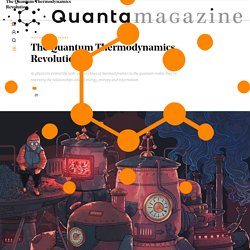
To Carnot’s surprise, he discovered that a perfect engine’s efficiency depends only on the difference in temperature between the engine’s heat source (typically a fire) and its heat sink (typically the outside air). Work is a byproduct, Carnot realized, of heat naturally passing to a colder body from a warmer one. Carnot died of cholera eight years later, before he could see his efficiency formula develop over the 19th century into the theory of thermodynamics: a set of universal laws dictating the interplay among temperature, heat, work, energy and entropy — a measure of energy’s incessant spreading from more- to less-energetic bodies.
Entropy as Uncertainty What to Tell Technologists. Quantum Theory Could Actually Be About Us. Physicists know how to use quantum theory—your phone and computer give plenty of evidence of that.

But knowing how to use it is a far cry from fully understanding the world the theory describes—or even what the various mathematical devices scientists use in the theory are supposed to mean. One such mathematical object, whose status physicists have long debated, is known as the quantum state. One of the most striking features of quantum theory is that its predictions are, under virtually all circumstances, probabilistic. Visualization of Quantum Physics (Quantum Mechanics) The Trouble with Quantum Mechanics. The development of quantum mechanics in the first decades of the twentieth century came as a shock to many physicists.
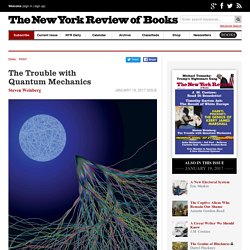
Today, despite the great successes of quantum mechanics, arguments continue about its meaning, and its future. The first shock came as a challenge to the clear categories to which physicists by 1900 had become accustomed. There were particles—atoms, and then electrons and atomic nuclei—and there were fields—conditions of space that pervade regions in which electric, magnetic, and gravitational forces are exerted.
Light waves were clearly recognized as self-sustaining oscillations of electric and magnetic fields. But in order to understand the light emitted by heated bodies, Albert Einstein in 1905 found it necessary to describe light waves as streams of massless particles, later called photons. Does knowledge of the past and present determine the future? Que sera seraWhatever will be will beThe future’s not ours to seeQue sera sera.

So sang Doris Day in 1956, expressing a near-universal belief of humankind: you can’t know the future. Even if this is not quite a universal belief, then the universal experience of humankind is that we don’t know the future. We don’t know it, that is, in the immediate way that we know parts of the present and the past. We see some things happening in the present, we remember some things in the past, but we don’t see or remember the future.
But perception can be deceptive, and memory can be unreliable; even this kind of direct knowledge is not certain. In the ancient world and, I think, to our childhood selves, it is events such as the York floods that make us believe that we cannot know the future. Why Feynman Diagrams Are So Important. Pilot-Wave Theory Gains Experimental Support. Of the many counterintuitive features of quantum mechanics, perhaps the most challenging to our notions of common sense is that particles do not have locations until they are observed.
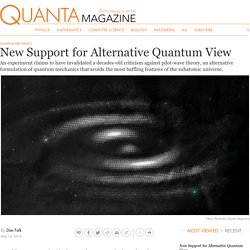
This is exactly what the standard view of quantum mechanics, often called the Copenhagen interpretation, asks us to believe. Instead of the clear-cut positions and movements of Newtonian physics, we have a cloud of probabilities described by a mathematical structure known as a wave function. The wave function, meanwhile, evolves over time, its evolution governed by precise rules codified in something called the Schrödinger equation. QuantumLevitation. Nothing to see: The man who made a Majorana particle - opinion - 13 May 2013. Physics: Bell’s theorem still reverberates. Physicist John Bell at CERN, Europe’s particle-physics lab near Geneva, Switzerland, in 1982.

In 1964, Northern Irish physicist John Bell proved mathematically that certain quantum correlations, unlike all other correlations in the Universe, cannot arise from any local cause1. This theorem has become central to both metaphysics and quantum information science. But 50 years on, the experimental verifications of these quantum correlations still have ‘loopholes’, and scientists and philosophers still dispute exactly what the theorem states. Experiment confirms quantum theory weirdness. The bizarre nature of reality as laid out by quantum theory has survived another test, with scientists performing a famous experiment and proving that reality does not exist until it is measured.

Physicists at The Australian National University (ANU) have conducted John Wheeler's delayed-choice thought experiment, which involves a moving object that is given the choice to act like a particle or a wave. Wheeler's experiment then asks -- at which point does the object decide? Common sense says the object is either wave-like or particle-like, independent of how we measure it. But quantum physics predicts that whether you observe wave like behavior (interference) or particle behavior (no interference) depends only on how it is actually measured at the end of its journey. This is exactly what the ANU team found. "It proves that measurement is everything. Two Diamonds Linked by Strange Quantum Entanglement. Scientists have linked two diamonds in a mysterious process called entanglement that is normally only seen on the quantum scale.
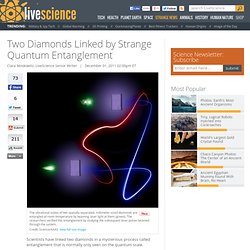
Entanglement is so weird that Einstein dubbed it "spooky action at a distance. " It's a strange effect where one object gets connected to another so that even if they are separated by large distances, an action performed on one will affect the other. Entanglement usually occurs with subatomic particles, and was predicted by the theory of quantum mechanics, which governs the realm of the very small.
But now physicists have succeeded in entangling two macroscopic diamonds, demonstrating that quantum mechanical effects are not limited to the microscopic scale. "I think it's an important step into a new regime of thinking about quantum phenomena," physicist Ian Walmsley of England's University of Oxford said. " Another study recently used quantum entanglement to teleport bits of light from one place to another. Chinese Physicists Smash Distance Record For Teleportation. Teleportation is the extraordinary ability to transfer objects from one location to another without travelling through the intervening space.
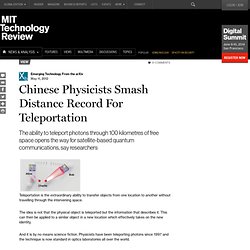
The idea is not that the physical object is teleported but the information that describes it. This can then be applied to a similar object in a new location which effectively takes on the new identity. And it is by no means science fiction. Quantum Teleportation Between Atomic Systems Over Long Distances. A new milestone has been reached in the development of a practical quantum teleportation system — researchers have for the first time succeeded in the teleportation of information between two separate clouds of gas atoms, over long-distances.
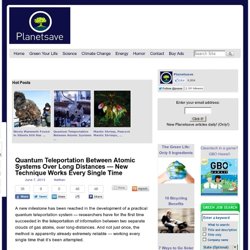
And not just once, the method is apparently already extremely reliable — working every single time that it’s been attempted. There are two glass containers, each containing a cloud of billions of caesium gas atoms. Both glass containers are enclosed in a chamber with a magnetic field. Mathematical breakthrough sets out rules for more effective teleportation. For the last ten years, theoretical physicists have shown that the intense connections generated between particles as established in the quantum law of 'entanglement' may hold the key to eventual teleportation of quantum information.
Now, for the first time, researchers have worked out how entanglement could be 'recycled' to increase the efficiency of these connections. Physicists Discover the Secret of Quantum Remote Control. Teleportation is one of the more extraordinary phenomena in the quantum world. It allows a quantum object, such as a photon or electron, to travel from one location to another without passing through the space in between. Teleportation is a standard procedure in any decent quantum mechanics laboratory. Physicists use it on a daily basis for quantum communication and quantum computation. If that sounds exotic, you ain’t seen nothing yet; teleportation is about to get a whole lot weirder.
That’s because until now, physicists have only been able to teleport single particles, one at a time. Fractal Patterns Seen in Semiconductor Magnetism : FractalFoundation.org. Fractal patterns have been observed for the first time at the quantum scale, and the implications – and applications – may be huge. Image: Roushan/Yazdani Research Group Mathematicians and physicists have known for some time that the equations that govern the magnetic phase-transition of metals will produce fractal patterns when iterated in a computer. But until now, nobody had ever seen actual fractal patterns at the nanoscale before. Now, in a serendipitous discovery, “fractal puddles” have been observed in the magnetization of semiconductors, and the discovery may lay the foundation for the emerging area of “spintronic” devices.
Read more:Princeton University announcement PhysicsWorldScience Magazine (original peer-reviewed paper, full article requires $) Long-Predicted Fractal Energy Pattern Observed For First Time By Physicists. Science Published on May 15th, 2013 | by Michael Ricciardi May 15th, 2013 by Michael Ricciardi Hofstadter’s butterfly in color. Golden ratio discovered in quantum world: Hidden symmetry observed for the first time in solid state matter. Researchers from the Helmholtz-Zentrum Berlin für Materialien und Energie (HZB), in cooperation with colleagues from Oxford and Bristol Universities, as well as the Rutherford Appleton Laboratory, UK, have for the first time observed a nanoscale symmetry hidden in solid state matter. The mention of “spin” of a particle is one that... - Say It With Science. Time and Quantum Physics relationships to Phi.
The Golden Ratio seems to be appearing in several places in the Quantum Physics Model. Because an electron has an electric charge and an intrinsic rotational motion, or spin, it behaves in some respects like a small bar magnet and is said to have a magnetic moment. Because the electron also has mass, it behaves in some respects like a spinning top, and is said to have spin angular momentum. Double time-reversal asymmetry could explain weird material behavior. Discovering Light. As of July 1, 2013 ThinkQuest has been discontinued.
Waves. As of July 1, 2013 ThinkQuest has been discontinued. Wave Motion Interference. Physics of Electromagnetic Waves.
Bohm's Gnosis: The Implicate Order. Quantum Bayesianism Explained by its Founder. Christopher Fuchs describes physics as “a dynamic interplay between storytelling and equation writing. Quantum mechanics 101: Demystifying tough physics in 4 easy lessons.